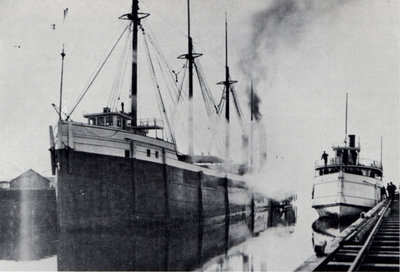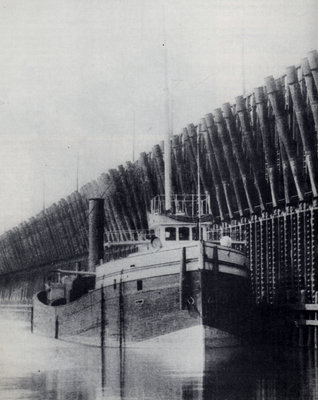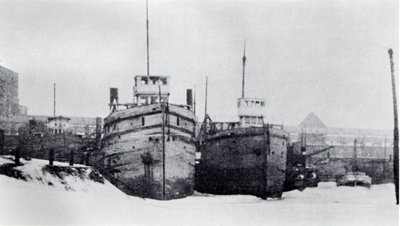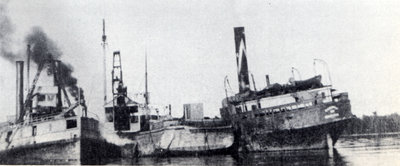Table of Contents
It is amazing how ideas for these features sometimes develop. Often, we try writing up the history of a vessel that has been suggested by one of our members, and on other occasions we simply work up one of our own ideas. And, in certain cases, it happens in a completely different manner. The selection process for this month's feature began back in October when we were looking over photographs of the wrecker CORNWALL, (a) KINGSTON (I)(73), (b) BAVARIAN (74), (c) ALGERIAN (04). One of the photos showed CORNWALL and the lightering barge HARRIET D., (a) ELEANOR, alongside the stranded steamer CABOTIA. Interesting as the photo was, however, we felt that it did not show enough of CORNWALL to merit inclusion in the November photopage.
Nevertheless, the more we thought about the photograph, the more we wondered whether we might be able to work up enough detail concerning CABOTIA to feature her in the December issue. This article is the result and, we hope, a happy one. It is all the more appropriate in that now we can use the CORNWALL photo (see the current photopage) while the history of that famous old steamer is still fresh in the memory of our readers. As far as we know, nothing major has ever been written about CABOTIA, so this will be a "first".
The history of CABOTIA can be traced back to 1880, when the oak-hulled bulk carrier was built at Gibraltar, Michigan, as Hull 21 of the Linn and Craig Shipyard. Constructed to the order of the Wilson Transit Company of Cleveland, Ohio, the vessel was launched on Wednesday, June 9, 1880, and was duly christened HIAWATHA. She was enrolled at Cleveland as U.S.95600. As built, she was 234.6 feet in length, 36.1 feet in the beam, and 19.9 feet in depth, with tonnage of 1398.72 Gross and 1159.90 Net.
Strangely, it has been reported that HIAWATHA was designed as a four-masted schooner-barge, although we have been unable to locate any record of her operating as such. Possibly there may have been some confusion in that vessels of her type were often referred to as "steam barges". In any event, regardless of what her original design may have been, it would appear that she was completed as a steamer. She was powered with a fore-and-aft compound engine, with cylinders of 25 and 50 inches, and a stroke of 46 inches. The engine was rated at 750 i.h.p. at 85 revolutions per minute, and was built in 1880 by the Frontier Iron Works at Detroit. We have no record of HIAWATHA's original boilers and would be grateful for the assistance of any readers who might have access to such information. (The steamer was reboilered less than a decade after her original entry into service.)
HIAWATHA was a handsome vessel, typical of the larger, wooden-hulled, bulk carriers which were built for the lake trade about 1880. She had a straight stem and a full forecastle. Her stocked anchors were carried on the spar deck inside the forecastle, with the stocks protruding on either side of the stem, and they were worked from a davit above. The forecastle head was surrounded by a closed rail, with a slightly raised section at its forward end.

HIAWATHA and the passenger steamer R. G. STEWART are seen at Duluth sometime between 1882 and 1889.
The pilothouse, a squarish structure with three large, sectioned, round-topped windows in its front and a window and door in each side, rested directly on the forecastle. Atop the pilothouse roof, which noticeably overhung the sides of the cabin, was located the open navigation bridge where the officers stood watch regardless of the weather conditions. There was little by way of navigation equipment on this "monkey's island", and helm orders were relayed into the pilothouse below by the simple means of a "cussing-box". Behind the pilothouse was a small texas cabin, which contained the master's quarters, and from its roof protruded bridgewings that ran right out to the sides of the ship.
A closed wooden rail ran all around HIAWATHA's spar deck, right to the stern, and from it were suspended heavy fenders which were designed to protect the steamer's hull planking when she was manoeuvring at close quarters. She had a heavy counter stern and a good-sized after cabin with a prominent iron boilerhouse. Two tall, thin, and well-raked stacks, set athwartship, rose from the aft cabin. However, HIAWATHA's most impressive feature was her four very tall, fidded masts, on which auxiliary sail was carried in the fashion of the day. Each mast carried a heavy boom on which the sail was furled when not in use, and the mizzen also sported a heavy gaff.
In latter years, the vessels of the Wilson Transit fleet wore black hulls, but such was not the case back in HIAWATHA's time. Her hull was, we believe, painted dark green, while the forecastle, deck rail and cabins were white. The stacks were all black. There was dark trim (possibly either green or brown) on the cabin windows and the masts.
HIAWATHA appears to have operated mainly in the iron ore trade between Lake Superior and Lake Erie ports, and her name certainly was appropriate for a ship trading regularly into the waters of Lake Superior and, particularly, those bordering the Upper Peninsula of Michigan. She seems to have been successful and we are not aware of any accidents befalling her during her years of service for the fleet founded by the famous Captain Thomas Wilson.
In those days, however, marine technology was advancing very rapidly, with newer and larger vessels being turned out by the lake shipyards each season. As a consequence, HIAWATHA was soon superceded in the ore trade by more modern tonnage and, in 1887, she was sold to Burke and Company of Buffalo. These new owners re-registered the steamer at Buffalo. Perhaps in an effort to provide more steam than her original boilers could produce, in order that her engine might operate at the greatest possible efficiency, HIAWATHA was given two Scotch boilers, measuring 12 feet by 12 feet, 6 inches, which were built by the Lake Erie Boiler Works at Buffalo in 1889. We have no confirmation of when these new boilers were actually installed in HIAWATHA, but we have the feeling that they were built especially for her and fitted immediately. They would serve her for the rest of her lifetime.

HIAWATHA is loading ore at a Lake Superior port in this spectacular photo dating from the 1890's.
With the installation of the new boilers, HIAWATHA's original two funnels were removed and replaced by a single stack, very tall and much heavier than either of the originals. This new funnel rose from a turtle-backed iron boilerhouse which we believe to have been new to the steamer at this time, for it differed from the first one she carried. As well, the need for auxiliary sail having disappeared by this time, HIAWATHA's four original fidded masts were removed, and in their place was fitted a single, tall and very heavy pole mast, set just abaft the pilothouse. On the mast was carried an extremely long boom, and it is possible that sail could still be set if required in the event of an emergency.
By this time, HIAWATHA sported a big canvas weathercloth on a higher rail around the open navigation bridge, and also a high framework on which could be stretched a canvas awning on hot summer days. A few other nice touches also had been added, including two large ventilator cowls on the forecastle head, which scooped fresh air downward into the crew's quarters located below. There were very few openings in the sides of the forecastle cabin, and the wooden steamers generally were known for the damp, foul, airless quarters located there. Ventilators were undoubtedly considered a great improvement, although in comparison with today's standards, the lot of those consigned to such accommodations was unenviable indeed.
By 1891, the ownership of HIAWATHA had passed to Lane et al. of Buffalo, according to Beeson's directory, and in 1893 she was acquired by Joseph C. Gilchrist of Cleveland for operation in his famous Gilchrist Transportation Company fleet. Joseph C. and Frank W. Gilchrist were two of the most well-known shipping entrepreneurs on the U.S. side of the lakes in the years around the turn of the century, and they set up a great number of small companies (all under their control) to own the various vessels in the fleet, the ships often being transferred from company to company in the group to suit financing requirements at any given time. HIAWATHA was registered at Sandusky, Ohio, after Gilchrist purchased her, and it would appear that her registry was transferred to Vermillion, Ohio, in 1899. (The U.S.M.V. for 1899 shows her registry still as Sandusky, while the 1899 Great Lakes Register shows her home port as Vermillion.) By 1905, HIAWATHA had been re-registered at Cleveland, which by then was the centre of the Gilchrist operations.
When HIAWATHA joined the Gilchrist fleet, she was painted in their plain but rather attractive colours. Her hull was black with a high grey boot-top that was visible at the stem and fantail even when the vessel was loaded. All of the Gilchrist fleet's steel-hulled steamers had black forecastles, but the company realized that such a colour scheme did not suit the many wooden vessels which it operated, and all of the latter, including HIAWATHA, had white forecastles and cabins. HIAWATHA's stack was all black, as were the funnels of all of the Gilchrist boats for the entire lifetime of the fleet. HIAWATHA flew a dark blue houseflag, on which was emblazoned a large white letter 'G'.
All of the Gilchrist ships carried their operator's name in a very distinctive form on their bows, the white letters being grouped something like so:
The Gilchrist Transportation Co.
Strangely enough, however, this legend was almost never carried in such a position that it was centred either over or under the ship's name!
With the advent of the new century, the Gilchrist fleet sprang to the forefront of the U.S. lake shipping scene, and ordered numerous groups of steel-hulled bulk carriers from a variety of lake shipyards. But the company overextended itself and, when economic conditions became depressed, it wound up with severe cash-flow problems, owing huge sums to the shipyards which had constructed its newer vessels, and to various banks to which others had been mortgaged. Accordingly, when Joseph C. Gilchrist, the power behind the fleet, suffered a debilitating stroke that forever removed him from the leadership of his own company, it could no longer continue its operations. Even court-appointed receiver-operators were unable to turn the situation around, and eventually the fleet was dissolved. The steel-hulled steamers were sold off to other operators in classes, and the wooden ships were dumped at bargain-basement prices to whosoever would take them.
When the break-up of the huge Gilchrist fleet began in earnest in 1913, HIAWATHA was sold to Alex McLaurin of Montreal. He transferred her to Canadian registry, enrolling her as CABOTIA (C.133825) at Montreal, under the ownership of the Cabotia Steamship Company, Montreal. One might speculate as to whether the name of the steamer and the company had anything to do with the famous Venetian navigator Giovanni Caboto (John Cabot) and his son Sebastian, who voyaged to North America during the late 1400s and early 1500s in the service of England, but in reality we have no idea whatsoever as to how the steamer's new owner settled on this unusual name.
Likewise, we have absolutely no knowledge in respect of the colours carried by the ship whilst she was owned by the Cabotia Steamship Company. As far as we are aware, there exist no photographs of CABOTIA during this stage of her career. However, typical of many of the miscellaneous wooden-hulled steamers of the period, she probably wore a black hull, with white cabins and a black stack, those colours revealing to observers nothing at all concerning the ownership or operation of such vessels.
In 1916, CABOTIA was acquired by the Canada Shipping Company of Montreal, a firm which had close connections with the George Hall Coal Company of Canada Ltd., Montreal. In fact, the George Hall Coal Company of Canada Ltd. became the actual registered owner of CABOTIA in 1918. By this time, CABOTIA had been given the light grey hull which vessels of the Hall fleet wore at that period, as well as the usual black stack with the white "wishbone" and letter 'H' which for so many years were a familiar sight on the lakes. In addition, CABOTIA had received a rather flimsy, square, wooden upper pilothouse, which appeared to perch rather precariously on her monkey's island. It was rather ugly and provided little more than "basic" shelter but undoubtedly it was appreciated by the officers who formerly had to brave all sorts of weather whilst standing watch on the open bridge. As well, CABOTIA by this time had received a very light pipe mainmast, stepped aft of the stack, and a section of the wooden deckrail had been opened up around the fantail. These changes did little if anything to improve the vessel's appearance and, in fact. the pipe aftermast seems to have been removed again in 1919, for it is not in evidence in a stern photo of the ship aground later that year.

SENATOR DERBYSHIRE (left), CABOTIA and JAMES W. FOLLETTE (right) are laid up at Montreal in this photo taken during the winter of 1918-1919.
When CABOTIA was brought into Canadian registry, she had been remeasured and her dimensions were shown by the Dominion List of Shipping to be 243.5 feet in length, 35.6 feet in the beam, and 19.6 feet in depth, with her tonnage listed as 1530 Gross, 932 Net. Her engine horsepower was shown as 104.
CABOTIA, however, was not to remain long in the Hall fleet, for at about 6:00 a.m. on Monday, August 25, 1919, she ran ashore on Main Duck Island in Lake Ontario. The "Main Ducks", lying very close to the navigation channel, had long been a hazard to shipping, particularly in foggy weather, and a lighthouse had been erected on Main Duck Island in 1915. As we noted in the November issue, however, this lighthouse was not enough to prevent the Fairhaven Transportation and Coal Company's wooden-hulled steamer ROCK FERRY, (a) MERRIMAC (11), from grounding on the island in May of 1916, and in 1919 the shoals took CABOTIA as their victim.
Some sources have indicated that the stranding of CABOTIA took place on August 29, 1919, but the date of August 25th is confirmed in the fact that, on August 26, the accident was reported to the Canadian Department of Marine and Fisheries by the Main Duck Island lightkeeper, Fred Bongard. He quoted Capt. W. J. Mills, master of CABOTIA, as having stated that the stranding was due to a "misjudgment". Captain Mills was but a young man at the time and in 1920 he was skipper of Hall's steamer FRED MERCUR. He later was appointed to command the canal steamer CASCO, of the Lakes & St. Lawrence Navigation Company Ltd. (the Canada Strach [sic] Company), and he served in her right through to the end of her active career, moving over with her in 1955 to the Paterson fleet, for which she operated as (b) THORDOC II.
In any event, CABOTIA had gone very hard aground in the Main Ducks, and as the photo accompanying this feature will indicate, her stern was heavily twisted to port. This, no doubt, was due to the torquing effect produced by her engine continuing to run ahead after her bow was already aground, thus twisting the weakened and almost-40-year-old wooden hull. Accordingly, CABOTIA was considered to be a total loss, even though steam was kept up in her boilers, and she was abandoned to the underwriters.
The insurers let a salvage contract to the Donnelly Salvage and Wrecking Company Ltd. of Kingston, which attended at the scene of the stranding with the sidewheel wrecking steamer CORNWALL and the lighter barge HARRIET D., and eventually their efforts proved successful in refloating CABOTIA. The Donnelly firm became the registered owner of CABOTIA in 1920, probably as payment for the successful removal of the wreck, but the deteriorated condition of the old steamer was such that she never operated for Donnelly in any capacity. She finally was abandoned at Kingston in 1921, and we have been unable to find any mention of the final disposition of either CABOTIA's hull or her machinery.

The wrecker CORNWALL, lighter HARRIET D., and grounded CABOTIA are seen at Main Duck Island in an August 1919 photo. Willis Metcalfe collection, courtesy Lorne Joyce.
Thus, after four decades of faithful service to many owners, the career of HIAWATHA/CABOTIA came at last to its end. She lived a longer life than did most of the wooden-hulled steamers of her era, and this is all the more a great credit to her original builders in that she had been designed for the iron ore trade, one that was particularly hard on a wooden vessel. Nevertheless, HIAWATHA lived through it, and survived to operate for many more years after her service in the ore trade was finished.
How times have changed! If only the technologically advanced vessels of today could look forward to lives as long as that of this little wooden steamboat.
Previous Next
Return to Home Port or Toronto Marine Historical Society's Scanner
Reproduced for the Web with the permission of the Toronto Marine Historical Society.